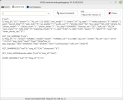Hi
If i understand correct the camera for the drone is communicating over wifi.
So then a may be able to build a custom camera using a raspberry ore similar.
But to get started, a need some help how the communication works between the drone and the camera
Today I understand the drone connects to the wifi of the camera and gets an IP address (can't remember the address will lookup)
the password for the camera was 0123456789
Then the drone properly starts using some stream for the camera, and that is sent back to the st16 controller.
control starting and stopping video may be done with some HTTP calls.Also the gimbal has some connector for power and control of the gimbal anyone knows what the connectors are and what kind of data they send ?
If i understand correct the camera for the drone is communicating over wifi.
So then a may be able to build a custom camera using a raspberry ore similar.
But to get started, a need some help how the communication works between the drone and the camera
Today I understand the drone connects to the wifi of the camera and gets an IP address (can't remember the address will lookup)
the password for the camera was 0123456789
Then the drone properly starts using some stream for the camera, and that is sent back to the st16 controller.
control starting and stopping video may be done with some HTTP calls.Also the gimbal has some connector for power and control of the gimbal anyone knows what the connectors are and what kind of data they send ?




